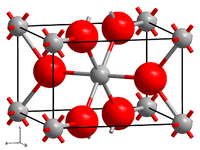Technetium (IV) oxide
| Crystal structure | |||||||||||||
|---|---|---|---|---|---|---|---|---|---|---|---|---|---|

|
|||||||||||||
| __ Tc 4+ __ O 2− | |||||||||||||
| General | |||||||||||||
| Surname | Technetium (IV) oxide | ||||||||||||
| other names |
Technetium dioxide |
||||||||||||
| Ratio formula | TcO 2 | ||||||||||||
| Brief description |
brown-black solid |
||||||||||||
| External identifiers / databases | |||||||||||||
|
|||||||||||||
| properties | |||||||||||||
| Molar mass | 129.91 g mol −1 | ||||||||||||
| Physical state |
firmly |
||||||||||||
| density |
6.9 g cm −3 |
||||||||||||
| Melting point |
900 ° C (sublimation) |
||||||||||||
| Hazard and safety information | |||||||||||||
 Radioactive |
|||||||||||||
|
|||||||||||||
| As far as possible and customary, SI units are used. Unless otherwise noted, the data given apply to standard conditions . | |||||||||||||
Technetium (IV) oxide is an inorganic chemical compound of technetium from the group of oxides .
presentation
Technetium (IV) oxide can be obtained by decomposing ammonium pertechnetate at 800 ° C.
It can also be obtained from other technetium oxides by heating in air.
The dihydrate is formed by the reaction of ammonium metal hexachloride with an ammonia solution .
properties
Technetium (IV) oxide is a brown-black solid. It crystallizes in a distorted rutile structure of molybdenum (IV) oxide . At 900 ° C it begins to sublime and disproportionate above 1100 ° C into technetium and technetium (VII) oxide . It is oxidized to TcO 4 - by nitric acid or hydrogen peroxide . It's weakly paramagnetic. The dihydrate changes into the anhydrous form when heated to 300 ° C in vacuo.
Individual evidence
- ↑ a b c d e f Georg Brauer (Ed.) U. a .: Handbook of Preparative Inorganic Chemistry. 3rd, revised edition. Volume III, Ferdinand Enke, Stuttgart 1981, ISBN 3-432-87823-0 , p. 1599.
- ^ A b H. Harry Julius Emeleus, AG Sharpe: Advances in Inorganic Chemistry and Radiochemistry . Academic Press, 1968, ISBN 0-08-057860-8 , pp. 21 ( limited preview in Google Book search).
- ↑ The hazards emanating from radioactivity do not belong to the properties to be classified according to the GHS labeling. With regard to other hazards, this substance has either not yet been classified or a reliable and citable source has not yet been found.
- ^ AF Holleman , E. Wiberg , N. Wiberg : Textbook of Inorganic Chemistry . 101st edition. Walter de Gruyter, Berlin 1995, ISBN 3-11-012641-9 , p. 1500.
- ↑ Joseph Steigman, William C. Eckelman, National Research Council (US). Committee on Nuclear and Radiochemistry: The chemistry of technetium in medicine . National Academies, 1992, pp. 57 ( limited preview in Google Book search).

![{\ displaystyle {\ ce {(NH4) 2 [TcCl6] + 4 NH4OH -> TcO2. 2 H2O + 6 NH4Cl}}}](https://wikimedia.org/api/rest_v1/media/math/render/svg/af19dff480ddf998bbd400d9e11cc4620cf1ac77)